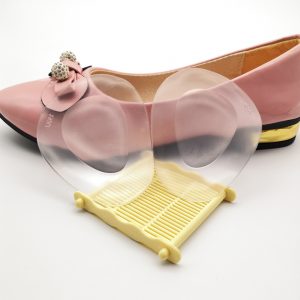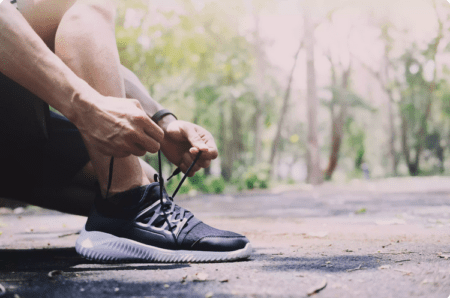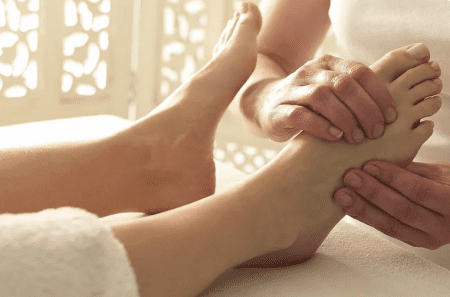You’re not alone if your feet ache after a long day at work or play. It happens to most people when you overdo it, but there are factors that can make you more prone to getting sore feet. Learn about the causes and prevention of sore feet and how to soothe them.
Common Causes of Aching Feet
Your sore feet likely stem from a few known causes and risk factors:
- Abnormal foot anatomy: Common problems include flat feet, an excessively high arch, and arthritis or joint restriction.
- Obesity: Carrying excess weight results in increased strain on ligaments, muscles, and joints.
- Overuse: Increased walking or standing, especially when combined with other contributing factors, can cause even the healthiest feet to become sore. Also, walking or standing on hard surfaces, such as concrete, can stress your feet. This can be a problem for those who stand all day at work or are generally on their feet for long periods of time.1
- Pregnancy: In addition to the stress caused by increased weight, pregnancy hormones cause the ligaments that stabilize your feet to relax. These two factors together result in excess strain on your feet.
Poorly-Fitting Shoes
Whether or not you have other risk factors, your shoes can be the source of foot pain or make it worse. To keep ped pain at bay, your shoes need to be the right size and shape. Keep in mind that your footwear needs may change as you age since your feet often change over the years.
For instance, if tendons and ligaments lose elasticity and stretch, you may need a larger shoe size. Or you may develop a bunion or hammertoes and need a wider shoe.
A sloppy (too roomy) fit is also bad, overworking your muscles as your feet shift around in the shoe and increasing the risk of blisters and black toenails. Another footwear faux pas is wearing shoes that are lacking in support and cushioning, which can leave your feet feeling fatigued and sore.
8 Ways to Soothe Foot Pain
Besides kicking back and giving your feet a rest, here are some remedies that can help ease the ache and rejuvenate tired feet:
Employ Moist Heat
Sometimes aching feet are simply the result of overstressed muscles and connective tissue due to excess activity or weight-bearing. One of the best remedies for relaxing sore muscles is a foot bath.3 Soak your feet in a basin of warm water or a store-bought foot spa for five to 10 minutes.
Try adding Epsom salts to the water for an added soothing effect. Epsom salts are readily available where first aid products are sold. Use approximately 1 to 2 tablespoons per gallon of warm water. If your feet are swollen, hot, or tired, use cool water instead of warm and elevate your feet for a half hour or more after the soak.
Stretch Your Feet
Overstressed muscles will tend to contract or spasm. To counteract this tightness, stretch your feet.
A good time to stretch is after a warm soak when your muscles will be relaxed.
Sit in a comfortable position and stretch the ankle and toe joints using your hands or a strap. To also target the calf muscles, try a runner’s stretch while leaning against a wall. Hold each motion comfortably for 10 to 20 seconds for maximum benefit.
Give Feet a Workout
Exercises for your ankles, feet, and toes will help stretch, strengthen, and relax them.
- Pick up objects with your toes and move them from one pile to another.
- While standing, rise up on your toes, lifting your heels off the ground.
- Do ankle pumps, moving your foot up and down.
- Make circles with your ankles.
- Roll the bottom of your foot on a frozen water bottle, tennis ball, or golf ball.
Engage in Touch Therapy
Apply oil or lotion to the soles of your feet and massage while applying gentle thumb pressure to any sore areas. Focus on the plantar fascia, the prominent cord-like structure that runs the length of the arch from the ball of the foot to the heel.
You can best feel the plantar fascia on the sole of your foot when you flex your toes upward. The plantar fascia is an important anatomical structure because it helps give form and support to the arch, which is necessary for absorbing shock when your feet hit the ground.
A tight plantar fascia can often be a root cause of heel soreness. Other hands-free ways to massage the feet is by using a foot roller or a foot spa with built-in massage.
Wear Arch Supports
Try a pair of over-the-counter arch supports for your shoes. Arch supports will help decrease the shock that your feet experience with every step. The heel and ball of the foot are especially prone to soreness and full-length arch supports will help cushion these areas.
Visit a shop that specializes in arch supports to get recommendations from the experts there. If your problem still bothers you, see a podiatrist and discuss custom-made orthotics. These offer even more support for the feet and have the added benefit of accommodating specific foot problems such as plantar fasciitis and flat feet.
Check Your Shoes
Identify which shoes may be contributing to your foot soreness. Switching to running shoes or shoes with a stiffer sole may help. Even sandals come in styles that cradle the arch and have a slightly thicker sole, which is preferable.
Also, if your shoes have excess wear and tear they may be contributing to your sore feet. Worn-out soles can change the dynamics of how your feet hit the ground, thus throwing off your biomechanics.
Since shoes that are too tight or too loose can lead to soreness and fatigue, have your feet measured the next time you buy shoes. You may be surprised to find out that you were wearing an incorrect shoe size.
If you have bunions, hammertoes, or a neuroma (a painful thickening of the tissue around a nerve), make sure your shoes are wide enough and deep enough in the toe box.
Trim Calluses and Corns
The hard, dry skin of calluses and corns can create pressure on the bottom of your foot, and lead to cracks, bleeding, or infection.7 Soak your feet in warm water for a few minutes. Dry them and use a pumice stone or emery board on the hard spots. Apply a moisturizing lotion, then put on socks to seal in the added hydration.
Consider Acupuncture
Acupuncture is a traditional Chinese medicine practice that research shows can be of benefit for foot pain, although the studies often have flaws such as publication bias.










Thanks for your blog, nice to read. Do not stop.